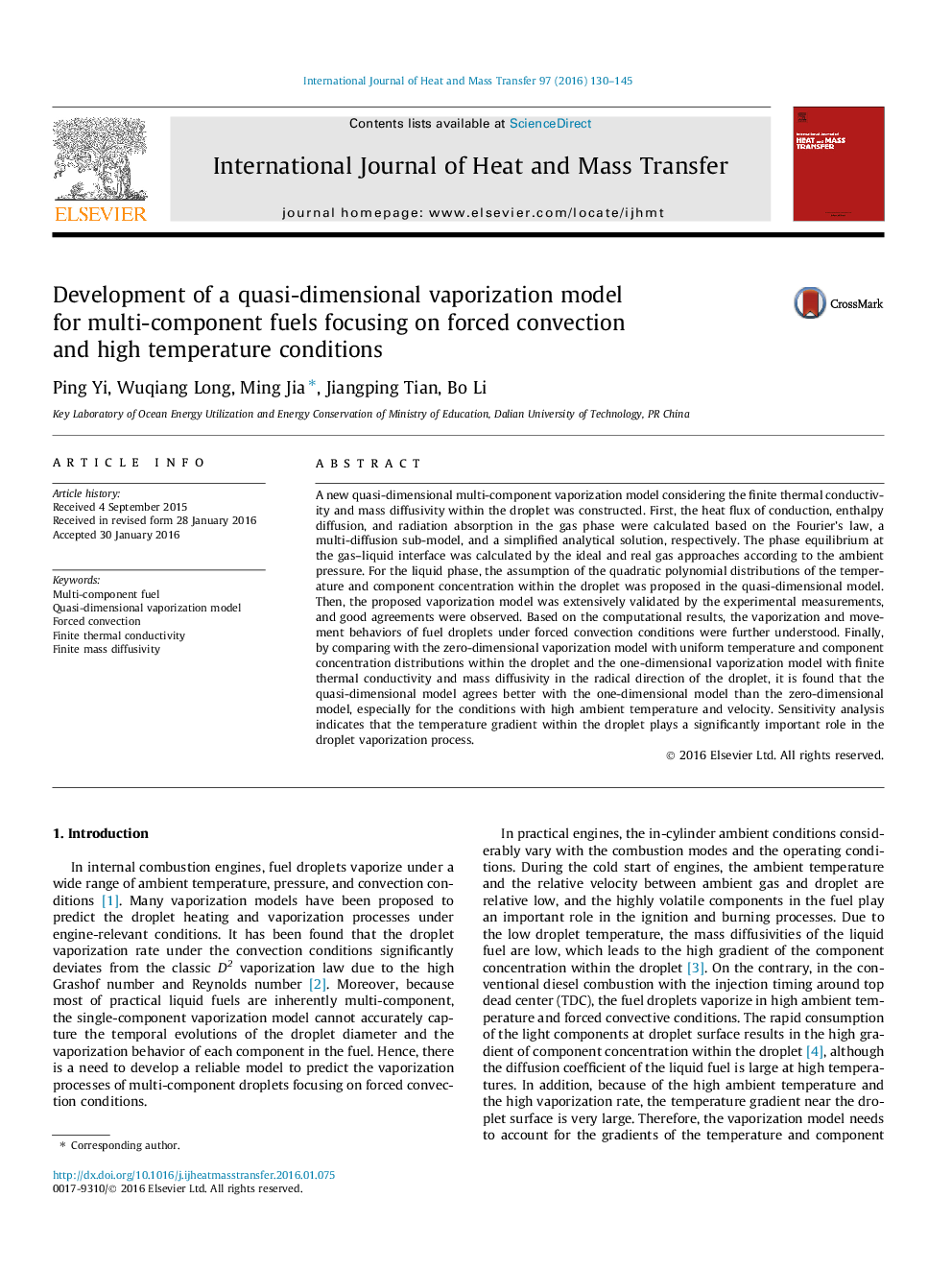| کد مقاله | کد نشریه | سال انتشار | مقاله انگلیسی | نسخه تمام متن |
|---|---|---|---|---|
| 7055540 | 1458045 | 2016 | 16 صفحه PDF | دانلود رایگان |
عنوان انگلیسی مقاله ISI
Development of a quasi-dimensional vaporization model for multi-component fuels focusing on forced convection and high temperature conditions
ترجمه فارسی عنوان
توسعه یک مدل تبخیر شش بعدی برای سوخت های چند جزء با تمرکز بر ترمهای مجاز و شرایط دمایی بالا
دانلود مقاله + سفارش ترجمه
دانلود مقاله ISI انگلیسی
رایگان برای ایرانیان
کلمات کلیدی
سوخت چند جزء، مدل تبخیر نیمه ابعاد، کنسانتره اجباری، هدایت حرارتی محدود توزیع جرم محدود،
ترجمه چکیده
مدل تخلیه چند جزء شبه ضلعی با توجه به هدایت حرارتی محدود و انتشار جاذب درون قطره ساخته شد. اولا، شار حرارتی هدایت، انتشار آنتالپی و جذب تابش در فاز گاز به ترتیب بر اساس قانون فوریه، زیر مدل چند نفوذ و یک راه حل تحلیلی ساده محاسبه شد. تعادل فاز در رابط گاز و مایع با توجه به فشار محیط به روش های ایده آل و واقعی گاز محاسبه شده است. برای فاز مایع، فرض توزیع چند جمله ای درجه دوم درجه حرارت و جزء در داخل قطره در مدل نیمه بعدی پیشنهاد شده است. سپس، مدل تبخیر پیشنهاد شده به وسیله اندازه گیری های تجربی به طور گسترده ای مورد تایید قرار گرفت و توافق های خوب مشاهده شد. بر اساس نتایج محاسباتی، رفتار تبخیر و حرکتی قطرات سوخت تحت شرایط مجاورت محصور بیشتر درک شد. در نهایت، با مقایسه مدل تبخیر با ابعاد صفر با توزیع غلظت دما و مولفه های جزئی در داخل قطره و مدل تبخیر یک بعدی با هدایت حرارتی محدود و انتشار جرم در جهت رادیکال قطره، مدل بعدی، بهتر است با مدل یک بعدی از مدل بعدی صفر، به ویژه برای شرایط با دمای محیط و سرعت بالا، بهتر است. تجزیه و تحلیل حساسیت نشان می دهد که گرادیان درجه حرارت در داخل قطرات نقش مهمی در فرایند تبخیر قطرات دارد.
موضوعات مرتبط
مهندسی و علوم پایه
مهندسی شیمی
جریان سیال و فرایندهای انتقال
چکیده انگلیسی
A new quasi-dimensional multi-component vaporization model considering the finite thermal conductivity and mass diffusivity within the droplet was constructed. First, the heat flux of conduction, enthalpy diffusion, and radiation absorption in the gas phase were calculated based on the Fourier's law, a multi-diffusion sub-model, and a simplified analytical solution, respectively. The phase equilibrium at the gas-liquid interface was calculated by the ideal and real gas approaches according to the ambient pressure. For the liquid phase, the assumption of the quadratic polynomial distributions of the temperature and component concentration within the droplet was proposed in the quasi-dimensional model. Then, the proposed vaporization model was extensively validated by the experimental measurements, and good agreements were observed. Based on the computational results, the vaporization and movement behaviors of fuel droplets under forced convection conditions were further understood. Finally, by comparing with the zero-dimensional vaporization model with uniform temperature and component concentration distributions within the droplet and the one-dimensional vaporization model with finite thermal conductivity and mass diffusivity in the radical direction of the droplet, it is found that the quasi-dimensional model agrees better with the one-dimensional model than the zero-dimensional model, especially for the conditions with high ambient temperature and velocity. Sensitivity analysis indicates that the temperature gradient within the droplet plays a significantly important role in the droplet vaporization process.
ناشر
Database: Elsevier - ScienceDirect (ساینس دایرکت)
Journal: International Journal of Heat and Mass Transfer - Volume 97, June 2016, Pages 130-145
Journal: International Journal of Heat and Mass Transfer - Volume 97, June 2016, Pages 130-145
نویسندگان
Ping Yi, Wuqiang Long, Ming Jia, Jiangping Tian, Bo Li,
